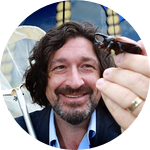About This Project
Pollinators are vital to the maintenance of life. They assist flowering plants (including most human food crops) to reproduce. This ecosystem service, pollination, is at risk worldwide because pollinators are declining. This is a particular problem in cities where honey bees are the dominant pollinators. We want to find out how honey bees respond to the pressures of life in cities by developing a new method of testing worker health.
Ask the Scientists
Join The DiscussionWhat is the context of this research?
Pollinators are declining globally and this is a threat for both -the survival of natural habitats, and the efficient food provision of humans. Insect pollinators are vulnerable to a range of environmental pressures , including habitat fragmentation and loss.Urbanisation is a driver of habitat fragmentation so understanding its effect on pollinator communities is important if we want to minimize it.
I will measure the condition of honey bees in the city of Sydney, Australia and compare how the condition of urban and non-urban population differs. I will do this by quantifying body mass, tibia length, hairiness, and wing wear. This last trait (wing wear) will be measured with high-resolution photography, without hurting the bees.
What is the significance of this project?
Understanding the threats that cities pose on the condition of pollinators, will help us plan future cities in a more sustainable way. If we achieve to make cities friendlier for wildlife, then future generations will be able to enjoy more biodiverse cities, provisioned by a wide array of ecosystem services. Orchards, backyards, urban crops, veggie patches and gardens will enjoy a wider array of healthier pollinators, having higher fruit yields and reproduction rates.
What are the goals of the project?
I want to compare how urbanisation affects honey bee condition, by quantifying bee conditions in the urban gradient. I will do this by using high resolution photography, which is a novel technique for this kind of application.
Knowing what is making honey bees have a difficult time in the cities is important, and will help us plan environmentally friendlier cities in the future. The second goal of my project is to identify the main environmental factors that affect honey bee condition in the urbanisation gradient. I will do this by analyzing satellite images and performing vegetation surveys around the study sites.
Budget
I need to take high resolution pictures to bees' wings without killing them. I want to compare the condition of bees in places with different urbanisation levels, and this can be done by analyzing the differences in wing wear, body mass, and other morphological features. I plan to capture the bees, mark, weigh, photograph and then release them. I will return to that same location three and six days later to recapture, photograph and record their morphological characteristics again.
This lens and flash will allow me to take reliable, high quality pictures under variable environmental conditions in the field, without having to hurt the bees.
Endorsed by
Meet the Team
Manuel Lequerica
I grew up surrounded by nature in the lush Andes mountains of Colombia, and have always been fascinated by plants and their interaction with animals (including us, humans). Everything from plant biochemistry and physiology to forest ecology intrigues me; I consider myself a Naturalist more than a Biologist.
I did my B.Sc. at Universidad de Los andes , in Colombia, with a particular focus on high-Andean forest ecology. I then moved to Australia, where I finished a M. Agr. (Environmental Economics) at The University of Sydney, and got involved in a research project that studied the economic impacts of sewage (with agro-industrial origin).
My current research (in the Integrative Ecology Lab, at the School of Life and Environmental Sciences in The University of Sydney) revolves around the effects of urbanisation on wildlife, in particular plants and pollinators. I am interested in understanding how the growth of cities has a (negative or positive) impact in plant and animal populations both locally and remotely.
Project Backers
- 38Backers
- 100%Funded
- $2,506Total Donations
- $64.26Average Donation


